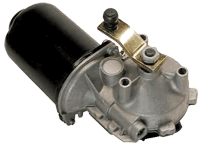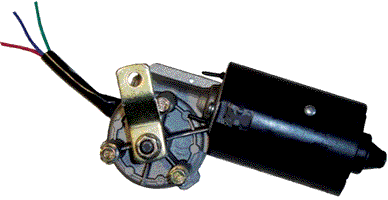
Using a wiper motor in your Halloween projects
by Scary Terry
 |
Using a wiper motor in your Halloween projects by Scary Terry |
|
Ever since I posted some projects using wiper motors, I've gotten a steady stream of email asking questions about how to use them in Halloween devices. There's a lot of information on the web dealing with wiper motor use in cars (imagine that!), a little info for using them in robots, but very little else. This page is my attempt to provide some information for how to use them in other devices. I am certainly not an expert on the subject, just one who has used them in many projects and would like to share what I've learned. This web page is based on the motor made by Trico (their part #23000387) for Saturn Automobiles. Alas, sources for this motor seem to have dried up (as of 4/08). Since so many of these motors were sold, I will keep the specific info for them up for some time to come. I will also start to provide information on other motors as I find out about them (see below). Much of the information I present applies to wiper motors in general. Contrary to what some believe, the wiper motor does not oscillate back and forth, it rotates continuously in one direction like most other motors. The rotational motion is converted to the back and forth wiper motion by a series of mechanical linkages. Here's a page that shows how this works in a car http://auto.howstuffworks.com/wiper1.htm This type of motor is called a"gearhead" or "gear motor" and has the advantage of having lots of torque. My unscientific test (using one wiper motor and a torque wrench) found that at 12 volts, on high speed, the motor has 13.5 pound-feet and on low speed, has 17.5 pound-feet of torque. So the Saturn wiper motor is no longer available, what do I do? Don't fret, there are other motors available. Certainly you can purchase a new motor from an auto dealer or auto parts store and pay big bucks, but most of us don't want to spend that kind of money (usually $60 and up). Surplus dealers can be a great source of these motors and I offer a list of many of them at the end of this article. Unfortunately, their selection changes from month to month and what's being offered today might not be available tomorrow. |
|
| Monster Guts offers a new wiper motor that's very similar to the Saturn motor. They have a consistent stock of them and they're priced under $20. They also offer power supplies and a motor speed control. | Here's a side by side comparison of the Monster Guts motor (left) and the Saturn motor. As you can see, beside the fact that the gearbox is on different sides, they are very similar in size and methods of mounting. The electrical connections are also very similar(you'll find pin-outs for both on the next page). The Monster Guts motor is a bit slower with speeds of 38-53 rpm (12 volts) and 15-21 rpm (5 volts). More details on the Monster Guts website. |
| FrightProps is another source for a new motor and motor accessories. Their motors feature wires already attached to simplify wiring and a shaft arm ready to attach to your prop. They also have a variable speed power supply (see below). |  |
|
Powering the motor
|
Here are some types of power sources I've used. (A car battery can also be used) |
|
Voltage. The standard voltage requirement for the wiper motor is 12 volts DC. The electrical system in a running automobile usually puts out between 13 and 13.5 volts, so it's safe to say the motor can handle up to 13.5 volts with no problem. I wouldn't recommend any voltages higher than that. Current. The minimum required current for the motor is 1.6 amps at 70 rpm, 0.9 amps at 41 rpm (and 4 amps if you elect to run it at 106 rpm, see note on the next page). These current ratings are for the motor spinning with no load. As you add mechanical load, these numbers can increase dramatically, doubling or even tripling under a heavy load. (When testing for torque, I found the motor to draw close to 14 amps in a stalled condition.) This factor must be taken into account when selecting a power supply. Since the motor will only use what it needs when it comes to current, it's best to provide a source with a higher current rating than you think you might need. I would recommend a 5 amp or greater supply to handle most circumstances. Most power sources are labeled as to their output current. Be aware that the milliamp (or ma) is 1/1000 of an amp, so something labeled 500 ma is only 1/2 amp, and probably will not drive the motor. Note: I've gotten several questions about using a switching power supply with the wiper motor where, when power is applied, the motor runs in a jerky motion. My best guess as to why this is happening is because the motor draws more current in the few moments when it first starts up (called inrush current). With some lower current switching power supplies, this may trigger circuitry which is designed to protect the supply. The power supply senses an overcurrent condition and shuts down. It will then restart, once again sense overcurrent and shut down. This pattern will continue to repeat which causes the jerky motor operation. It's hard to predict which supplies will do this, the best advice I can offer is to select a supply with an output of at least 5 amps.
|
|
| On to page 2 |
| Halloween Home | last update 12/2016 |